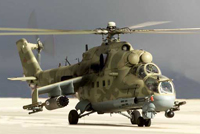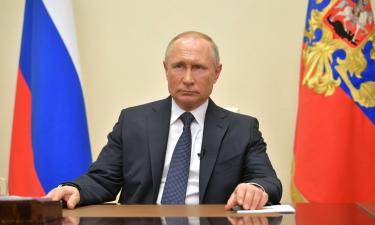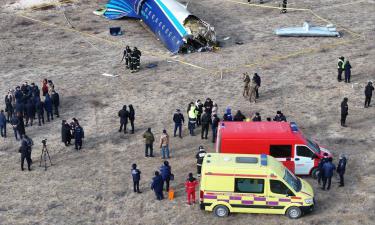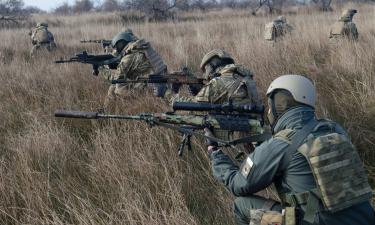'Helicopters of Russia' took off
JSC "United Industrial Corporation "Oboronprom" finished formation of the Russian helicopter holding. The specially created managing company "Helicopters of Russia" will run the industrial assets of the helicopter industry.

Yuri Ivanov from Sukhoi (former deputy head of KnAAPO) was appointed General Director of "Helicopters of Russia". According to the General Director of Oboronprom Denis Manturov "Helicopters of Russia" will have the functions of marketing and developing technological programs. Oboronprom will remain responsible for forming the strategy of developing helicopter industry and determining model range (keeping in mind the proposals of "Helicopters of Russia"). Delivery of spare parts, repair and after sale service of the hardware exported under the military contracts will also remain the responsibility of Oboronprom.
Oboronprom used to have the management of helicopter programs. Now these people will work in the "Helicopters of Russia". They already manage helicopter assembly plants. It is expected that Oboronprom will suggest passing over its helicopter related shares to "Helicopters of Russia" in the end of the year. This decision has to be approved by the state, the main shareholder. It will allow for attracting in the further other partners or shareholders. After a while it is planned to introduce “common shares”. Then "Helicopters of Russia" will become a uniform enterprise. Denis Manturov refused to voice the plans of introducing common shares, as it could negatively influence the stock market.
In the nearest future Oboronprom plans to keep 100 % of the shares of "Helicopters of Russia". Later it plans attracting strategic partners and working in the financial markets. Naturally, this will be coordinated with the state as the basic shareholder.
The nearest task today is finishing the formation of a full-fledged structure. Today Oboronprom has five final assembly plants; some of them need to switch over to making components. Out of the Kamov group of companies Oboronprom owns only the design bureau of Kamov. It is planned to integrate the Arsenyev and Kumertau plants before the end of the year. Respective documents are being considered by the government.
Originally the integration of "Progress" was not planned. Then prepared draft decree of the President of the Russian Federation and the government provided for taking over just Kumertau plant. However, the visit of the First Vice-Premier Sergey Ivanov to the Far East in September, 2006 resulted in the decision to include "Progress" into the helicopter holding. Consequently the already prepared documents had to be re-coordinated. It caused some delay.
It has been officially announced that the 49% of the stock of the JSC Kamov managed by RSK MiG will be exchanged for the shares of Oboronprom after MiG becomes a JSC or enters OAK. Moreover, today both Rosobronexport and Oboronprom publicly confirm the possibility of exchanging stocks between OAK, Oboronprom and “Helicopters of Russia”. However, this may take 3-5 years, when all parties are organizationally ready for such deals.
As of today Rosoboronexport owns 21% of the stock of Kazan Helicopter Plant. Together with the 30% belonging to Oboronprom it makes the controlling interest. With the other the situation also became clear. Oboronprom is the participant of the additional emission of Rostvertol, which is to be finished by the end of this September. As a result Oboronprom will get at least the blocking stock (together with the state owned package of 3,44%). In the end of this year or in the beginning of the next there will be the second stage of additional emission of shares. Oboronprom will either buy or initiate yet another additional emission to get the controlling stock.
The newly formed helicopters holding it to present the following model range:
In the niche of light helicopters Russia will be represented by Mi-34 and Aktai. The price of the latter will be maximum $300 000. Mi-34 is going to be a little more expensive. Therefore Mi-34 might be made in small series. Probably in this class Russia will buy a foreign license before Aktai reaches the market. Final decision will be taken in the end of year when the first three Aktais start flight tests.
In the class of 2-3 tons with one engine it is most likely that Russia will prefer license assembly of a foreign model, probably, in Ulan-Ude. This helicopter is to fill in the gap between Aktai (1,5 tons), Ка-226 (3,5 tons) and "Ansat" (3,5 tons). It is nearly certain that this will be Augusta-Westland. Sometimes Russia will arrange manufacturing of all types of helicopters of national design. However, today to refuse from license manufacturing in this class would mean wasting about 5 years.
Old project announced in 90s Mi-44 (2.2 tons) and Mi-52 (1.2 tons) remained on paper.
Ansat (3,3 tons) and Ка-226 (3,4 tons) will remain both. Ansat is regarded as very perspective helicopter. Ка-226 enjoys good demand in the market. This year it is planned to sell 5-10 Ка-226, and in the following - about 15. Ка-226 has a unique opportunity to land on very limited space; Ansat is convenient for long flights. BesidesKа-226with Rolls-Royse engines there will be one more version - with Turbomecca engines. Respective R&D was already started.
In the niche of 4,5 tons where earlier Russian Mi-54 was planned a new helicopter together with the foreign partner will be created. It will have two versions with Russian and foreign engines. It will be convenient for foreign certification. From scratch the helicopter will be made according to the certification requirements of FAR and JAR. In this niche today there are only AS365 and EC155 of Eurocopter, but they are already old. Therefore by the moment Russia suggests new helicopter this niche will be free (unless Eurocopter does not make something totally new).
Ka-60 and Ka-62 will represent the class of 6.5 tons. However, keeping in mind absolute absence of financing for these helicopters, absence of the engine, probably, it is also easier to arrange license manufacturing having agreed with the foreign partner on the possibility to introduce technical modifications to the helicopter. Kazan Helicopter Plant used to offere Ansat-3 in this class, however, this project is very raw and has little chances to be viable.
In the class of about 8-9 tons there will be a joint project with India. This project already goes on. Transmission is ready. Fuselage is being developed. It is feasible to bring the helicopter to the market in about 5 years.
The next range of helicopters is Mi-17. This helicopter will be in good demand for the next 10-15 years for sure. It is constantly modernized. For example, it got the new transmission made for Mi-28, a number of new elements for designed for Mi-38.
Summarizing the recent statements of the top people of Russian helicopter industry it is possible to conclude that Mi-38 remains in the production plans, however, in limited series, probably 5-10 units a year. Ka-32 enjoying very good demand in sophisticated markets of Northern America, Europe and Japan will be further promoted. This year it is planned to finish certification of this model according to the international standards. Mi-26 has a stable niche in Russia and with foreign operators.
Russia does not refuse from cooperation with Eurocopter. In particular Russian companies are interested in possible manufacturing of the components for Eurocopter using unutilized production capacities. The world faces a helicopter boom, both Eurocopter and Agusta Westland are full of orders and therefore both companies should be interested in passing over some manufacturing to the subcontractors with free capacities. Also with Eurocopter Russia participates in NATO’s working group on heavy helicopter with take-off weight of 10-12 tons.
At the same time European proposals on making EC145 in Kumertau are not acceptable, as this is a direct competitor of Ansat and Ka-226.
The problem of transferring the manufacturing of the Ukrainian engines to Russia recently got a new interesting shade. Denis Manturov, for example, said that this is quite politized matter. According to him from the point of view of economy creating from scratch parallel manufacture of engines which had been made by "Motor Sich" for 30 years is senseless. “If the state has money, it is better to spend them on new perspective development of the helicopter engines which do not exist now at all. For example, for Ка-226, Ansat, Ка-60, helicopters with 4,5 tons take off weight”. On the other hand, about 60% of the components used by "Motor Sich" are made in Russia. So it is quite a question who depends on whom”, he said. At the same time the head of Oboronprom acknowledged that it is reasonable to have additional limited assembly of VK-2500 engines.
According to the official data of the Russian Ministry of Industry in 2006 Russian aviation industry made 93 helicopters. It means 16% on top of the previous year (80 units). In 2006 Kazan, Ulan-Ude, Rostvertol, Kumertau plants made helicopters Mi-17-V5, Mi-17-1V, Mi-172, Mi-8-MTV1, Mi-8-MTV2, Ansat, Mi-26Т, Ка-32А-АТ, Ка-32А11BS, 23D2. Arsenyev based Progress made two Ka-50 "Black sharks". Rostvertol made five Mi-28N. The greatest growth of production was demonstrated in Ulan-Ude and Kazan. Export grew as well. Main deliveries in 2006 were to Venezuela and China. Six helicopters Mi-17V-5, three Mi-172, eight Mi-35 and one Mi-26Т totally worth $230 million were delivered to Venezuela. China received first 12 helicopters Mi-171 of civil version within the 2006 contract on 24 units. Western sources claim that six Mi-17 were delivered to Chad. Some helicopters were delivered to Sudan, Mexico and Burkina Faso. Repair and modernization of helicopters are done for Peru and Kazakhstan. Kumertau plant delivered seven civil helicopters Ka-32 to South Korea and to Spain.
Experts point out that in the past year there was an enormous problem because of the falling dollar exchange rate. Some export contracts brought losses, some - zero profitability. Now Russian companies try to sign contracts in Euro. In 2007 the industry counts on the revenues of over $1 billion. Russian helicopter makers still depend on export, but this dependence is declining.
Yuri Seleznev
Subscribe to Pravda.Ru Telegram channel, Facebook, RSS!



